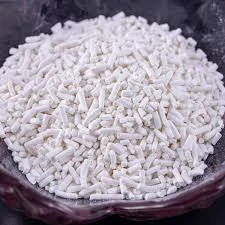
Understanding the Properties and Applications of Butyl Rubber in Modern Industries
Understanding Butyl Rubber Properties, Applications, and Benefits
Butyl rubber, also known as isobutylene-isoprene rubber (IIR), is a synthetic rubber that plays a critical role in various industrial applications. Invented in the 1940s, butyl rubber is characterized by its unique combination of properties that make it ideal for diverse uses, particularly where gas permeability and chemical resistance are essential.
Composition and Structure
Butyl rubber is produced through the polymerization of isobutylene with a small amount of isoprene. This results in a polymer with a high molecular weight that possesses a unique structure, leading to its superior properties. The absence of double bonds in the polymer backbone makes butyl rubber highly resistant to oxidation and UV radiation, which contributes to its longevity and durability.
Key Properties
One of the most notable properties of butyl rubber is its outstanding impermeability to gases, particularly air. This characteristic makes it an excellent choice for applications such as tire manufacturing, where maintaining air pressure is crucial for performance and safety. Additionally, butyl rubber exhibits excellent thermal stability, resisting a wide range of temperatures, which contributes to its performance in varied environments.
Butyl rubber is also resistant to many chemicals, including acids, alkalis, and water, making it suitable for sealing and insulation applications. Furthermore, its low hysteresis loss makes it effective in reducing rolling resistance, which is particularly beneficial for automotive tires, leading to improved fuel efficiency.
Applications
butyl rubber

The applications of butyl rubber are vast and varied, spanning diverse industries. In the automotive sector, it is commonly used for inner tubes, tire liners, and seals due to its gas impermeability and durability. Beyond automotive uses, butyl rubber finds applications in the manufacture of adhesives, coatings, and sealants, thanks to its excellent adhesion properties.
In the medical field, butyl rubber is utilized in the production of syringe stoppers and various medical devices. Its biocompatibility makes it a safe choice for products that come into contact with medications and biological materials.
Another significant application of butyl rubber is in the sport and recreational industries. It is frequently used in products such as inflatable boats, sports balls, and air mattresses, where its gas barrier properties ensure performance and durability.
Environmental Considerations
With the growing emphasis on sustainability, the production and disposal of synthetic materials like butyl rubber have come under scrutiny. While traditional butyl rubber is derived from petrochemical sources, advancements in research are leading to the development of bio-based alternatives and more sustainable manufacturing processes.
Companies are increasingly focusing on recycling and reusing butyl rubber to minimize waste and environmental impact. Innovative recycling technologies are enabling the recovery and reprocessing of used butyl rubber into new products, thus contributing to a circular economy.
Conclusion
In conclusion, butyl rubber is a versatile and valuable material that has set the standard for performance in various applications due to its distinctive properties. From automotive and medical to sporting goods, its utility is far-reaching. As industries pivot towards more sustainable practices, the ongoing research and development in butyl rubber production and recycling will ensure its continued relevance in a rapidly changing world. Whether in preserving the environment or enhancing product functionality, the importance of butyl rubber cannot be overstated, making it a vital material for the future.
-
Buy High-Quality Trichloroisocyanuric Acid for Sale | TCCA 90% SupplierNewsAug.30,2025
-
Pure Sodium Dichloroisocyanurate Dihydrate | Powerful DisinfectantNewsAug.29,2025
-
Industrial Chemicals: Quality & Purity for Every IndustryNewsAug.28,2025
-
Nitrile Rubber Honoring Strict Production StandardsNewsAug.22,2025
-
Aspartame Ingredients Honoring Food Safety ValuesNewsAug.22,2025
-
Fertilizer for Balanced Plant NutritionNewsAug.22,2025
-
Cyanide Gold Processing with High Purity AdditivesNewsAug.22,2025
Hebei Tenger Chemical Technology Co., Ltd. focuses on the chemical industry and is committed to the export service of chemical raw materials.
-

view more DiethanolisopropanolamineIn the ever-growing field of chemical solutions, diethanolisopropanolamine (DEIPA) stands out as a versatile and important compound. Due to its unique chemical structure and properties, DEIPA is of interest to various industries including construction, personal care, and agriculture. -

view more TriisopropanolamineTriisopropanolamine (TIPA) alkanol amine substance, is a kind of alcohol amine compound with amino and alcohol hydroxyl, and because of its molecules contains both amino and hydroxyl. -

view more Tetramethyl Thiuram DisulfideTetramethyl thiuram disulfide, also known as TMTD, is a white to light-yellow powder with a distinct sulfur-like odor. It is soluble in organic solvents such as benzene, acetone, and ethyl acetate, making it highly versatile for use in different formulations. TMTD is known for its excellent vulcanization acceleration properties, which makes it a key ingredient in the production of rubber products. Additionally, it acts as an effective fungicide and bactericide, making it valuable in agricultural applications. Its high purity and stability ensure consistent performance, making it a preferred choice for manufacturers across various industries.





